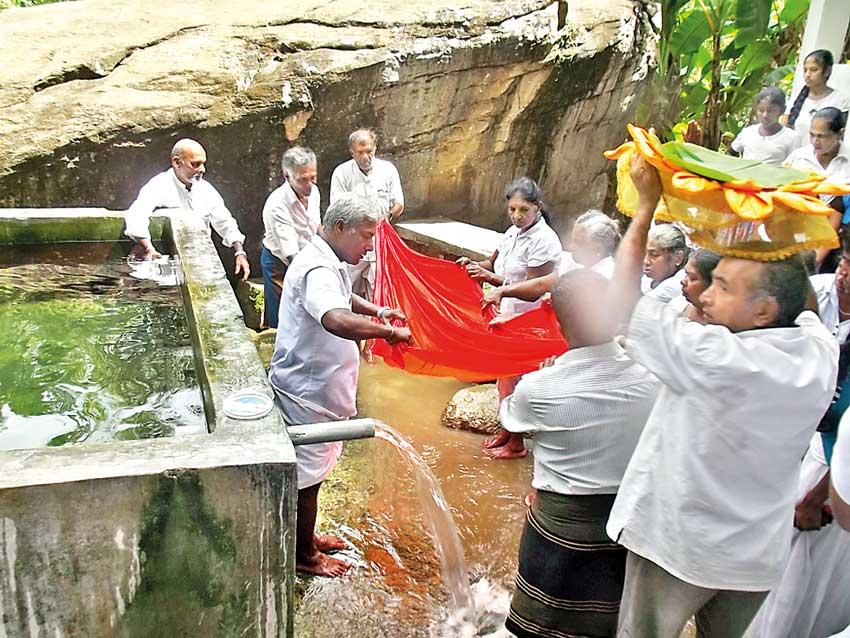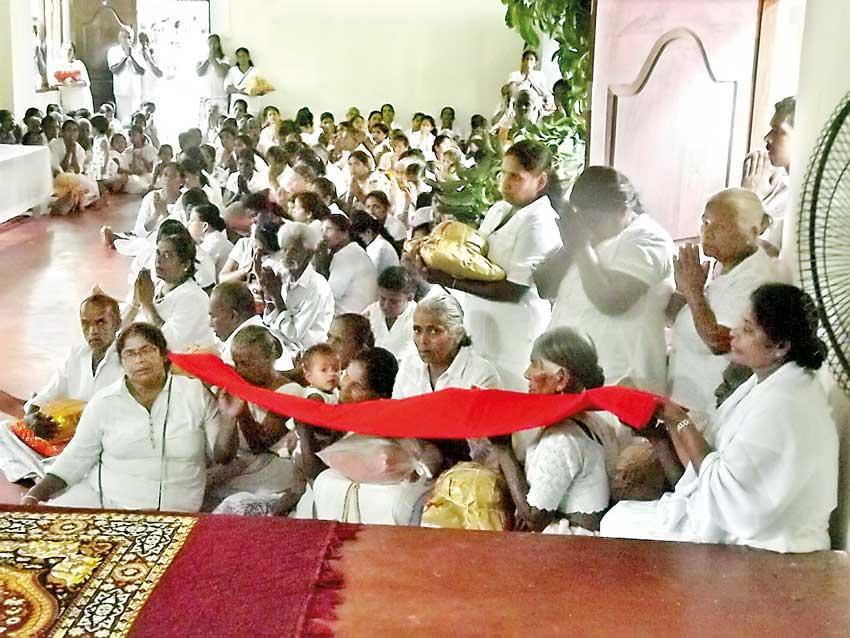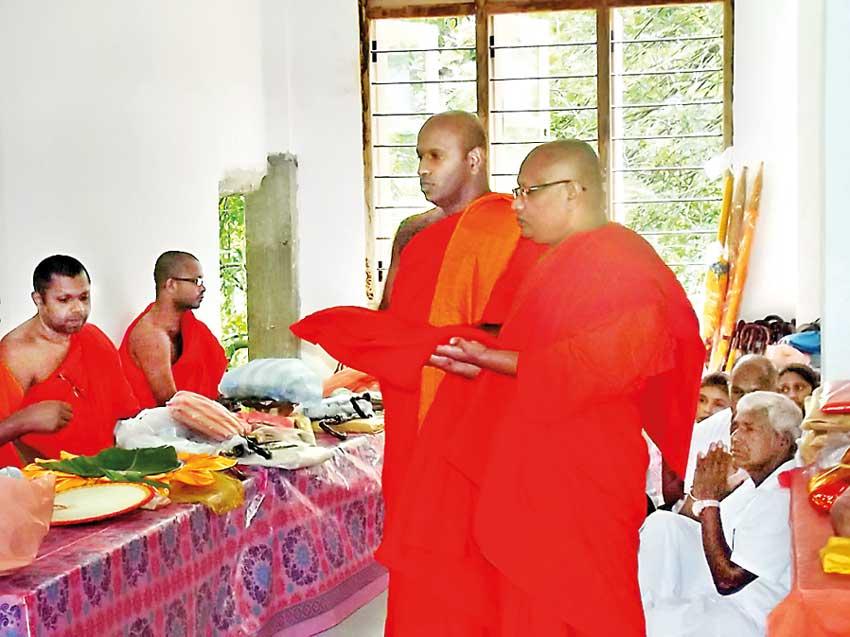31 Oct 2020 - {{hitsCtrl.values.hits}}

 Yesterday was Vap Poya and members of the Maha Sangha made their way to the ‘Poyage’, or Chapter House, to relieve of their undertaking of observing ‘Vas’ at the different temples in the country. They were in ‘Vas’, or retreat, for the last three months at temples, invited by the devotees of the temples in which they spent their retreat. By Il Poya, the Katina ceremonies should be over.
Yesterday was Vap Poya and members of the Maha Sangha made their way to the ‘Poyage’, or Chapter House, to relieve of their undertaking of observing ‘Vas’ at the different temples in the country. They were in ‘Vas’, or retreat, for the last three months at temples, invited by the devotees of the temples in which they spent their retreat. By Il Poya, the Katina ceremonies should be over.
This year there were two Vap Poyas. The one on October 1 was ‘Adi Vap’, which left some thinking last Poya was Katina. But it was not so. The service at the Sri Dalada Maligawa is the mark to judge the Poyas as they strictly observe the Buddhist calendar. An official there informs the astrological aspects of events to Maligawa authorities.
Some have mistakenly mentioned that ‘Katina’ had been offered during the last Poya, forgetting that this was an ‘Adi Poya’ according to the Buddhist calendar. There was an extra Poya this year, and the shift had occurred.
Villages during this period after three months of ‘Vas’ are a hive of activity making arrangements for the welfare of the monk, or monks, who had been invited to spend the three months of ‘Vas’ in their temples. After the three months the ‘Katina Cheevaraya’ is offered to the monks. Only one of them could be offered the Cheevaraya, or robe, and this is not decided by the devotees but by the congregation of monks who are present at the offering.
If one hears the throb of drums in the early hours of the morning during the period before Il Poya, one can rest assured the most important period of a monk is being carried out by his followers. This is the first indication that the ritual of the ‘Katina offering’ has commenced.

The greatest asset of a monk who had received Higher Ordination, or Upasampada, is the calling for ‘Vas’ during his life time. The offering of the ‘Katina Cheevaraya’ is said to have commenced around 588 BC, in the time of Buddha, while he was in Isipathanaramaya, Varanasi, India.
King Sri Rajadhi Rajasingha during his entire period of reign over the Kandyan Kingdom is recorded to have offered ‘Katina Cheevara’, and so did King Parakramabahu VI of Kotte. This is considered the greatest asset to any man or woman who participates in Katina ceremonies. Even touching the Cheevaraya is said to bring eight meritorious acts as enunciated by Gautama Buddha.
In the past, the fabric for the robes was obtained from cloth used to wrap dead bodies. The practice back then was for the dead to be taken to forests where they were wrapped in white cloth and left for wild animals. But whatever cloth that could be used had been used by monks for their robes or Cheevara.
How did ‘Vas’ originate? It began with five monks who were on their way to meet Gautama Buddha, but just sixty kilometres away they were met with heavy rains. They then spent their time meditating and living together. After the rains had ceased they recommenced their objective of meeting the Buddha, and they told him of their experiences. They said by traveling in the rain, they would be trampling other lives, both plant and animals.

The Buddha then instructed that they should refrain from traveling during the rainy season and meditate instead. He also said that whenever possible they should address the devotees for their deliverance. There were also groups who were antagonistic towards the Buddha and criticized his disciples traveling during the rainy season.
This also led to instructions to monks that they should curtail their movements during the rainy season. With this, the Buddha advised all monks to perform ‘Vas’ or what is called in other religions as ‘lent’ during the rainy season.
Monks who have observed ‘Vas’ prepare for the offering of the ‘Katina’ robe. Should a monk fail to observe ‘Vas’ on Esala Poya, he is entitled to observe ‘Pasu Vas’, a day after Nikini Poya, provided he retreats to the ‘Poyage’, or the area reserved for monks to hold ceremonies an rituals. But this does not entitle the member of the Sangha to receive the ‘Katina Cheevaraya’ after Il Poya.
Devotees all over the country are preparing to offer ‘Katina Cheevara’ to monks who have been in ‘Vas’ before Il Poya. The observances began from Esala Poya. During this season monks retreat to their temples. In the early days they went to forest caves to meditate. In areas where devotees were living they would preach the Dhamma of the Buddha for their way of life and deliverance. At the Aluvihare Vihare some cave abodes can still be seen to this day, and they are in a good condition.
During this period temple devotees arrange with the monks to listen to sermons, sometimes daily, in the evenings. Since last Poya, devotees in villages or urban areas have been preparing to offer the ‘Katina Cheevara’ before Il Poya to the monks who have been in ‘Vas’ in the last three months. Yet only one ‘Katina Cheevaraya’ can be offered at each temple, even if there are a number of monks who have been in ‘Vas’ during the season.
The ‘Cheevaraya’ is normally stitched and dyed in a ‘pandu oruwa’ made out of a log for the specific purpose of dying the robe. After it is dried, it is ceremoniously brought into the area where it is offered to the monks who have gathered to appoint a monk to receive the ‘Katina Cheevaraya’. This does not mean the monk who had observed ‘Vas’ at the particular temple is entitled to receive the robe. It is normally offered to the monk who has been on retreat. But even a monk who has only one robe is entitled to receive such a robe, though he may not have been in retreat in that particular temple.
So the ‘Katina Cheevaraya’ does not have to be offered to the very monk who had observed ‘Vas’ during the period in a particular temple. After it is offered, the monks select a monk from the congregation, or even one from outside, to offer the ‘Katina Cheevaraya’. The robe is then held by two senior monks and again it is offered to the congregation of monks. They in turn discuss as to whom the ‘Cheevaraya’ should be offered.
After their decision, the monk in question is offered the robe by the most senior monk. The recipient monk then goes through a process. In his stanzas he says the Cheevaraya would be with him, and he will touch it daily and be the third robe, as allowed by the Buddha. The robe is then marked by him with a key, having kept a betel leaf over the key so that a mark would be left to recognise the ‘Katina Cheevaraya’ over the other robes. Thus ends the Katina offering.
27 Nov 2024 1 hours ago
27 Nov 2024 2 hours ago
27 Nov 2024 3 hours ago
27 Nov 2024 3 hours ago
27 Nov 2024 3 hours ago